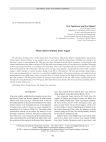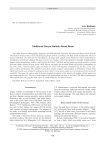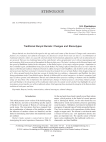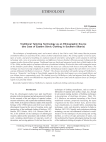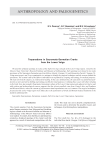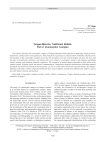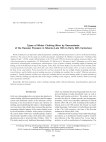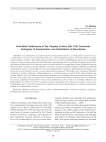Archaeology, Ethnology & Anthropology of Eurasia @journal-aeae-en
Статьи журнала - Archaeology, Ethnology & Anthropology of Eurasia
Все статьи: 524
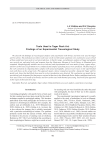
Tools used in Tagar rock art: findings of an experimental traceological study
Статья научная
We describe the findings of traceological analysis and experiments with bronze and iron tools used by Tagar and Tes artists. The pecking traces these tools leave on the red Devonian sandstone were examined to assess which of them could have been used in rock art production. At the first stage, a preliminary analysis of Tagar petroglyphs was carried out, and metal tools and weapons from the Martyanov Museum of Local History in Minusinsk were examined. Morphologically suitable ones were selected, and experimental tools were made of stone, copper alloys, and low-carbon steel. Experiments were conducted and samples of pecking traces were produced. The final stage of the work consisted of comparing these samples with actual petroglyphs, and use-wear traces on the experimental tools with those on the actual tools. This approach made a direct comparison possible. Among the Tagar and Tes metal tools, those that had likely been used in rock art production were detected. The conclusion was made that no specialized tools designated for that purpose existed at that time in the Minusinsk Basin. Rather, multifunctional tools were used. These were made of tin bronze and low-carbon steel with thermal processing. Such tools first appeared in the region in the Early Iron Age.
Бесплатно
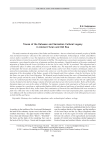
Traces of the Dahaean and Sarmatian cultural legacy in Ancient Turan and Old Rus
Статья
This study examines the migrations of the Dahae and Sarmatians—the two related early nomadic peoples of Middle Asia and Eastern Europe—directed to the south and west of their homeland. Archaeological, written, and folkloric sources make it possible to trace the migrations of the Dahae and Sarmatians over several centuries preceding the spread of Islam in Central Asia and of Christianity in Old Rus. The study focuses on mortuary monuments, temples, and sanctuaries, cross-shaped in plan view, of migrants and their descendants. A detailed analysis of the major southward migration of Dahae from the Lower Syr-Darya in the late 3rd to early 2nd BC is presented. This migration had a considerable effect on ethnic and cultural processes in Middle Asia. The migration aimed at conquering the lands of Alexander the Great’s descendants, who were rapidly losing control over them. Features of Dahaean culture are noticed in town planning, architecture, mortuary rites, armor, etc. over the entire territory they had captured. Southward migration of the descendants of the Dahae—people of the Kaunchi and Otrar cultures—from the Syr-Darya, led by the Huns, was part of the Great Migration. The Kaunchi people headed toward the oases of Samarkand and Kesh, the Otrar people toward the oasis of Bukhara, and those associated with the Dzhetyasar culture toward the Qarshi oasis. It is demonstrated that while the cross-shaped plan view of religious structures turned into the eight-petaled rosette, the fu neral rite did not change, remains of burials and charcoal are observed everywhere. Relics of the ScythoSarmatian legacy are seen in the culture of Old Rus. For instance, remains of the sanctuaries of Perun are walls and ditches arranged in a cruciform or eight-petaled fashion, fi lled with charcoal and bones of sacrifi ced animals, with a statue of the supreme Slavic deity, in the center. Early sanctuaries of Perun in Kiev and Khodosovichi were cruciate in plan view, while later ones on the banks of the Zbruch and the Volkhov rivers had octopetalous plans. Apparently they were infl uenced by the architectural traditions of Dahae and Sarmatians, who took part in the ethnogenetic processes in both Old Rus and Turan.
Бесплатно

Traditional bow of the Selenga Buryats (based on a 2019 field study)
Статья научная
Three Buryat bows, studied at Tashir village, in the Selenginsky District, Republic of Buryatia, in 2019, are described. They are relatively well preserved, and one is still functioning. A detailed description of their design is given. The specimens are similar in terms of morphology and technology (specifically, an outline without strings), design of transition zones, section of elastic part, and the shape and position of horn overlays. The tension force of the bows is evaluated, and conclusions are made about the impact of force and practical use. Comments made by a Buryat archer (the bow's owner) are cited about specific use under various weather conditions. The information is compared with that gained from ethnographic sources, and archival illustrations made in late 1800s and early 1900s are given.
Бесплатно
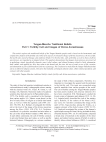
Tungus-Manchu traditional beliefs. Part 1: fertility cult and images of divine ancestresses
Статья
This article explores the traditional beliefs of the Tungus-Manchu peoples and is based on the hermeneutic and comparative analysis of the fertility cult. Some of its aspects are related to images of divine ancestresses, the tree of life, the hearth cult, ancestral lineage, and animistic beliefs. For the fi rst time, cults of fertility, as well as those of divine ancestresses, are regarded as an integral whole. This analysis demonstrates that images of ancestresses are preserved in mythology, rituals (specifi cally domestic ones), tribal culture, and cultural features related to birth, shamanism, ludic culture, and applied art. Also, they relate to the hearth cult, fi re rites, the tree of souls or tree of life, creation, and shamanism as part of folk medicine and rites of passage. The conclusion is made that the Tungus-Manchu fertility cult is an inherent religious system, relevant to the mentality, archetypal cultural values, ethno-cultural specifi city, and contacts with other peoples.
Бесплатно
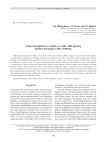
Turkic inscriptions in Cyrillic on 14th-15th century eastern European Lithic artifacts
Статья обзорная
Бесплатно
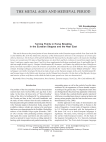
Turning points in horse breeding in the Eurasian steppes and the Near East
Статья обзорная
Бесплатно
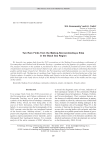
Two rare finds from the Maikop-Novosvobodnaya sites in the Black Sea region
Статья обзорная
Бесплатно
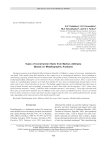
Types of construction nails from Markul, Abkhazia (based on metallographic analysis)
Статья научная
During excavations at the Markul fortified settlement, Republic of Abkhazia, a cluster of iron items, including nails, was found. Nails usually draw little attention as they cannot serve as chronological indicators. Several attempts at constructing a typology of nails have proved unsuccessful. The quality of metal of which they were forged has not been studied purposefully, although it can be relevant to the use of nails and construction practices. Here, we present the results of a metallographic analysis of 19 nails from Markul (13 spec. from a simultaneously formed cluster of iron items, and six spec. found elsewhere at the site). The findings suggest that they can be subdivided into three types in terms of metal structure and, accordingly, of properties of nails: those with a ferrite structure ("soft"), those with a ferrite-pearlite structure ("strong"), and those with a cementite structure ("extra strong"). These types correlate with three types of construction materials used in Abkhazia in the Late Classic and Medieval period. Lack of correlation between metric properties of nails and metal structure suggests that the latter was intentionally formed for specific tasks, depending on the characteristics of the details joined by nails.
Бесплатно
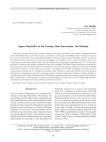
Upper Paleolithic of the Yenisey: new discoveries, old debates
Статья научная
This paper integrates the results of studies relating to the Upper Paleolithic of the Yenisey, collating traditional ideas with fi ndings made in the latest decades. Excavations on the Upper and Middle Yenisey are being carried out by several research teams. Sites representing the hitherto little known Early Upper Paleolithic (Yasnoye I, Afontova Gora II-Sklon) have been discovered, but so far the fi ndings do not suffi ce for their cultural attribution. The key site for that period in the region remains Malaya Syia, for which a series of new dates ranging between 34–29 ka has been generated. Traditions revealed there continued at a later site, Sabanikha. The Middle Upper Paleolithic is characterized by the prevalence of various blade industries, which in most cases cannot be separated into clear-cut groups resembling archaeological cultures. Certain industries are archaic, with Mousterian-like lithic assemblages and elaborate bone and tusk processing (Kurtak IV). During the later phase of the Pleistocene, along with cultures such as the Afontova and Kokorevo, blade industries survived, continuing traditions of the preceding stage (Golubaya I, Maltat, Konzhul). A peculiar variant of the Upper Paleolithic has been identifi ed, combining features of both cultures and a series of foliated bifaces (Kuibyshevo II). Discussions are ongoing around the effect of various factors on the cultural differentiation, including the relationship between the Afontova and Kokorevo cultures.
Бесплатно

Urbanization of indigenous peoples of Siberia and the Far East (20th to early 21st centuries)
Статья
Бесплатно
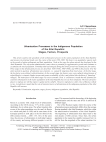
Статья
This article explores the specifi city of the urbanization process in the native population of the Altai Republic and assesses its principal trends over the course of the years 1926–2020. The focus is on quantitative aspects such as the growth of urban settlements and their population. I look at the ways the urban network has developed in the Altai Mountains. The only urban administrative center shows a potential for agglomerative growth and continues to accumulate the rural population. Townships that had emerged during the Soviet period were unattractive for natives. Three stages in the urbanization process are described: 1926–1950s, 1960–1980s, and 1990 to the present. Over the entire period in question, urbanization was extensive, i.e. caused by migration from rural areas. At the fi rst stage, the key factor was political (collectivization). In the second stage, the factors were socio-cultural (attractiveness of urban lifestyle), economic (higher income and greater availability of jobs), and political (the abolition of “futureless” villages). The main factor at the third stage was socio-economic crisis. A conclusion is made that the potential for extensive urbanization in the native population of the Altai Republic has not yet been exhausted. The most attractive places to migrate are still the region’s capital and its suburbs. However, migration to other cities of Russia is likely to rise. A prediction is made that the role of intensive factors of urbanization in the indigenous population of the Altai Republic will increase.
Бесплатно

